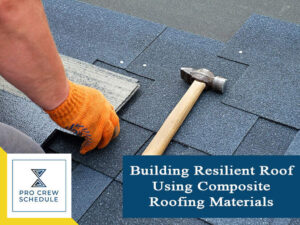In selecting roofing materials for commercial buildings, there is a wide variety of options. Roofers, as expected, are obliged to share their list of recommendations when it comes to roofing materials. On top of that, it is also necessary for them to be updated in the latest trends and technologies in the industry, including the construction scheduling software.
Composite roofing is considered today as a standard building material for waterproofing and covering different roofing styles. These roofs are also revered for its fire-resistant design, stylish appearance, and longer lifespan. Currently, it has been presented as one of the most intriguing and newest types of roofing today. These are often being called faux shingles because it has a mere resemblance to natural slate tiles. But for roofers, composite roofing materials are absolutely a strong contender from the list of considerations.
For this article, composite roofing will be further explained and the many advantages, including other essential details about it. Take a look below.
What Is Composite Roofing?
Composite roofing utilizes a mix of commonly-used roofing materials to allow much greater protection from the elements. By clear definition, it is the composite of various parts contributing to the strength of this particular roofing. In practicality, roofing professionals choose this material for so many reasons. One thing also that the prioritized is the use of software applications such as the builder trends software for well-planned project management.
Composite roofing is typically made from various materials like asbestos or asphalt shingles, shake, wood, laminate, tar paper roofing, shakes, slate, etc. When all of these materials are mixed all together, the “ingredients” tend to create a significantly superior roofing shingle. This variety of materials being used has allowed for much diverse composite shingles. Composite shingles are formed as well to replicate a wide range of colors and styles, such as shake, tile, or stone products.
Furthermore, this mixture of materials is explicitly selected for their resistance, durability, and improved insulating abilities. The same way goes for crew schedule software – this application is particularly selected further to improve the scheduling of tasks and overall project management.
Below are the common types of composite shingles:
· Architectural composite shingles – this type of shingles can be formed to mimic other materials like stone and shakes realistically. It will also overlap when being layered to create a solid textured appearance. These shingles also consist of many layers of polymer mineral fillers on fiberglass mats.
· Laminate composite shingles – an additional layer is usually added to this particular shingle to make it much thicker than the traditional 3-tab structure. For roofers to properly install the composite type of roofs, using a task scheduler software will make it easier. Work is more manageable, much more well-organized, and efficient using a software tool like this.
· 3-tab composite shingles – the primary center of this type of shingles comprises a fiberglass base or cellulose. The latter will be fully coated with tiny mineral fillers before being topped with a layer of ceramic granules or asphalt.
The Major Advantages of Using Composite Roofing Materials
Over the years, the composite roofing materials have indeed become a popular option in remodeling and new construction projects. Below are some of the advantages of using this type of roofing material.
1. Durability
Replacing roofs is commonly an expensive process that anyone wouldn’t want to undergo more often unless necessary. The replacements to any damaged roofs should only be considered when necessary, and roofers couldn’t agree. During replacement, those chosen materials for the process must have a strong reputation in terms of durability and resilience so that it can able to face many different elements and can withstand any tests of time.
It is also imperative to use construction scheduling software to manage any roofing projects and other roofing services efficiently. Apart from the project or the service itself, the involved crew is also efficiently supervised using this advanced tool. Every roofing subcontractor can benefit from it.
2. Wind Resistance
In several cases, composite or synthetic roofs can withstand strong winds of up to 120 mph. Thus, it only means that storms, hurricanes, or natural disasters cannot entirely damage this roof. It will efficiently perform stronger than ever. During the roof installation, roofing experts implement construction crew management to efficiently supervise the whole crew, track them, and work.
3. Impact Resistance
This particular feature is very crucial for numerous reasons. For example, the damage that can otherwise occur possibly from hail is much likely lesser to occur on synthetic roofs. It isn’t unreasonable to further seek out synthetic roofing composite materials with less than Class 4 impact resistance qualification. Bear in mind that this high-class measurement is only attainable from a few numbers of composite or synthetic roof manufacturers.
Composite or synthetic roofing materials are incredibly resilient and longer-lasting compared to any all-out-natural counterparts. These materials are particularly engineered to outlast cedar and other materials efficiently.
4. Fade-Resistance
One of the most common issues for roofing materials is fading. Over time, direct exposure from the sun can ultimately cause any pristine-looking roofs to become older and more unkempt. Regardless of using natural materials, even top-quality treatments cannot completely protect it from damage and harm. Good thing that composite materials for roofs are purposely created to have stronger resistance from the sun’s damaging effect.
5. Eco-Friendly
Composite types of roofs, whether recycled materials or not, are typically recyclable just when their lifespan is finally over. If that is always the case, it helps to reduce waste. Reducing waste has a good impact, particularly on the environment, because it promotes green living.
6. Strong Warranties
The majority of roofs these days are associated with a few different types of warranty. However, all those options that are created from all-natural products usually harbored a shorter guaranteed lifecycle in comparison with composite counterparts. Polymer-based composite roofs are offering excellent strength and resilience against impact damage and fire. Additionally, it comes also with strong warranties.
7. Cost
Slates are one of the common authentic roofing materials used for over centuries now. However, natural items like these tend to have more heavy price tags. In short, it is costly. Additionally, raw materials are more prone to cracking, chipping, and breaking. Synthetic or composite materials are opposite from them because these materials are directly manufactured with lightweight content. The majority of the content is even recycled matter, which only means that it is more cost-effective for any project.
Composite Roof Lifespan Expectancy
The mix of roofing materials has turned composite shingles such a very high-quality and excellent product. Composite roofs are recognized most for their durability feature. In comparison with asphalt roofing, this type of roof generally lasts for 20 years. However, with the best materials to use combined with proper maintenance, it will certainly last for more than 50 years. Accordingly, most composite shingles nowadays are carrying a warranty of 25-50 years, but bear in mind that the warranty length will typically depend right from the manufacturers.
What is the reason behind why composite roofs last so long? – It is a particular question that is often asked by many. Experts like roofers have believed that many factors directly contribute to the longer lifespan of composite roofing.
· Firstly, composite roofs are made from a mix of materials that creates a recipe for durability and strength
· It contains fiberglass-strengthening mats coated with mineral and asphalt fillers
· Composite shingles don’t have any issues with moisture and are fire-resistant
· Roofs like this are lightweight and are not easily cracked, warp, peel or break easily
Take note that how long a composite roof will last can also vary on environmental conditions:
· Ice – In icy conditions, the roofs are capable of contracting and expanding. If this is the case, it causes the roofs to become dislodged or loose. That is why, it is essential to have the composite roof shingles inspected before and after the winter season to ensure a tighter fit.
· Rain – During rainy seasons, water seeps into any existing cracks in the shingles. This issue might lead to the wooden structure below. It is essential to check on for any wet spots on an occasional basis. Many items could compromise the roof’s waterproofing ability.
Composite Roofing vs. Cedar Roofing (Natural Slate)
· First and foremost, composite shingles are found to be lighter in weight and, at the same time, not costly. As a matter of fact, composite roofs’ heaviness is about 30% that of natural slate. Thus, composite roofs are much easier in terms of installation and transportation.
· Ordinary roofs are capable of supporting composite synthetic slate shingles. Similarly, standard nails are capable of supporting it efficiently. Worrying for the roofs to break is unnecessary.
· In aesthetic sides, composite shingles are looking just equally attractive as the natural slate shingles. The composite cedar shakes are typically made of cedar wood shavings mixed with post-industrial plastics, used tires, or other UV-resistant materials.
· Finally, cedar roofing and composite roofing have both shared many similar qualities. However, the latter typically carries a much more extended warranty compared to standard cedar roofing.
Key Takeaways
When searching for the right roofing materials for future roofing projects, synthetic composite roofing stands out the best. Composite roofing materials are already proven to have several advantages compared to other materials available right now. It offers a much better value and is consistent in being resilient.







